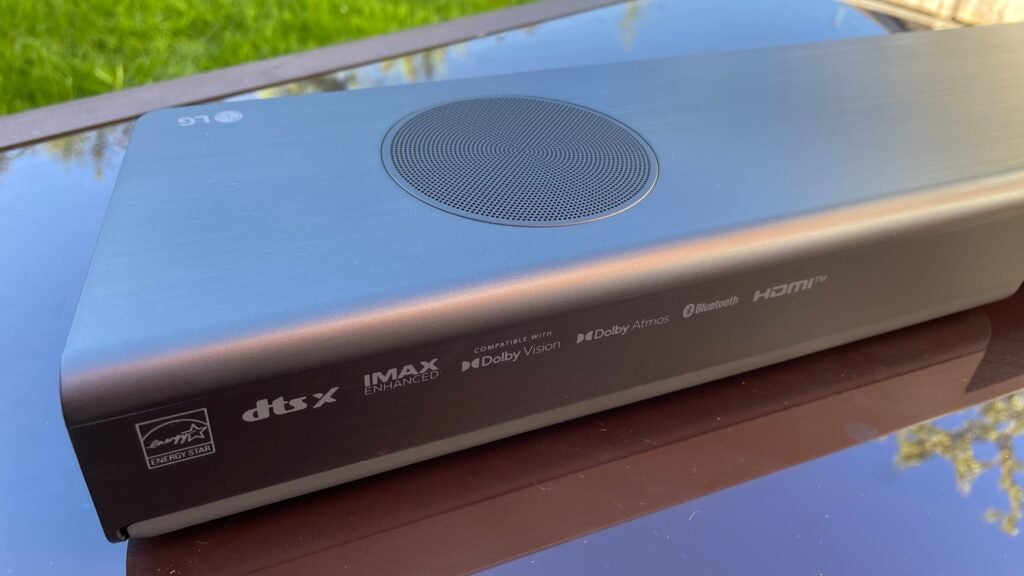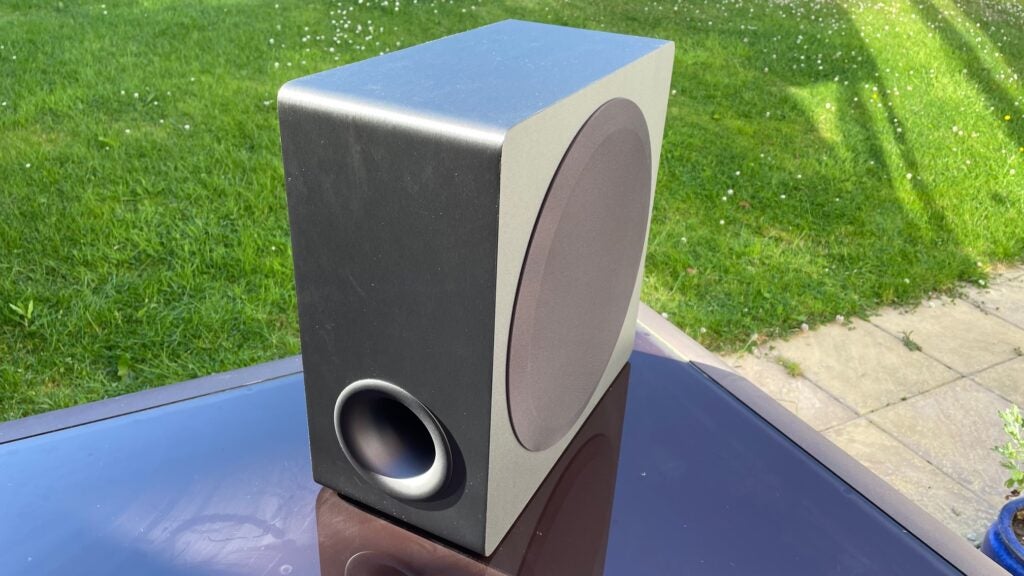Verdict
As well as heralding a potential new world of radically upgradable soundbars, the S95QR is also easily LG’s best soundbar ever – especially if you have a particularly big room to fill
Pros
- Colossally powerful, expansive sound
- Impressive connectivity
- Attractive, well built design
Cons
- No HDR10+ passthrough
- No HDR with 4K/120Hz passthrough
- The sound can sometimes feel slightly distant
-
9.1.5 channels of soundThat’s five from the front, four from the rear, plus five up-firers and a dedicated subwoofer.
Introduction
LG officially launched its S95QR flagship sound in 2022, but unusually it has continued the model on – keeping its flagship status – for 2023.
Even more unusually, though, it’s not now the same soundbar that it was when it first came out. That’s because LG recently lived up to a surprising promise it made back at the Consumer Electronics Show in January by rolling out by far the most substantial, wide-ranging firmware update the soundbar world has ever seen.
So does the new improved S95QR have what it takes to keep up with the all-new 2023 Joneses?
Availability
When the S95QR first came out it cost £1,699 in the UK – and it still does today. Whether you see that as a good deal considering it’s benefitted from the soundbar world’s biggest software update or a bit expensive for something that’s been around for longer than some of its closest rivals is a matter of perspective.
Less open to debate is the fact that its £1,699 price makes it a premium soundbar proposition, up against other soundbar ‘heroes’ such as the Sonos Arc plus Sub system and Samsung’s 16-channel HW-Q990C package.
Things start to look rather awkward for the £1,699 UK price when compared with its price (at the time of writing) in the US: $999.99. This is the result of a recent $800 reduction that will hopefully be more or less matched soon in the UK.
The S95QR is widely available across the world, with seemingly no direct replacement likely during 2023.
Design
- Comprises four separate components
- High quality finish and attractive shaping for the main soundbar
- Unusual third up-firing driver on the top edge
As well as eating up much less living room space than a typical separates audio system would, the LG S95QR is seriously attractive. Or at least three of its four components are, anyway.
The main soundbar sits low and wide, providing plenty of space for the speakers to operate without it butting into the pictures of most of today’s TV designs. Its sharp edges and corners and felt-covered front and sides combine with an elegantly brushed finish top edge to striking effect, while the addition of three grilled circular speakers within that top edge adds to the high-tech feel.
The S95QR is the first soundbar I’ve seen to feature three top-edge drivers; other premium Dolby Atmos soundbars only carry two. The extra driver is actually used by LG to repeat in a vertical direction the centre channel sound information that also fires out of a dedicated speaker in the soundbar’s front edge. The idea being to make dialogue and placement effects sound as if they’re coming from the screen above the soundbar.

The rear speakers included with the S95QR follow the smooth top/felt front and sides of the main soundbar, and also feature circular up-firers for Dolby Atmos height effects. Unusually, their front edges feature a roof-like triangular shape – a result of LG fitting two forward-facing drivers in each rear speaker pointing in different directions to achieve a fuller, wider surround sound experience.
I should say the two angled drivers in the front of each rear speaker only repeat the same rear left/rear right channel information; you’re not getting four different channels of sound. Even though LG counts the rear speakers as adding four channels to the ‘9’ part of the S95QR’s claimed 9.1.5 channel count.
If you’re counting, you’ll realise from the above that the main soundbar carries five channels of sound: centre, front left, front right, side left and side right.
The .1 bit of the claimed 9.1.5 channel count is provided by the least attractive element in the S95QR package: the subwoofer. This is relatively tall and slim by subwoofer standards, but would still be best hidden behind or down the side of a sofa if possible. So long as you don’t block the promisingly broad 8-inch driver built into one side.
The S95QR’s connections comprise two HDMI inputs, an HDMI output (so an HDMI loopthrough), an optical digital audio input, and the usual Bluetooth and Wi-Fi wireless options.

The S95QR ships with a basic but effective remote control that gets by surprisingly well on a very stripped back button count.
Two final design points of note are the inclusion on the front edge of an LED display, and on the top edge of a neat touch-sensitive row of control buttons.
Features
- Dolby Atmos and DTS:X playback
- 810W total power output
- 9.1.5 claimed channel count
The LG S95QR talks a very good game. For starters, it pushes the idea of what constitutes a soundbar to its limit by constituting four separate components: the main soundbar, a large subwoofer and two multi-channel rear speakers.
These components deliver a pretty mighty 9.1.5 claimed channel count.
Two of the channels in the ‘9’ bit are a tad optimistic for reasons discussed earlier, and the ‘5’ bit similarly includes one channel that’s actually an upfiring repeat of the main soundbar’s centre channel. To be fair, it’s clear that the S95QR’s speaker arrangement, whatever the channel specifics, is all about delivering not just true surround sound, but the sort of immersive hemisphere of sound, complete with overhead sounds, that’s so key to a full Dolby Atmos experience.

It’s worth saying that some aspects of the speaker design have been improved over the S95QR’s predecessor. The woofers in the main soundbar are bigger, enabling them to produce a wider dynamic range and shift more air, while the subwoofer driver has increased to eight inches from the predecessor’s seven.
A huge 810W of claimed power is shared around the S95QR’s drivers, and it’s no surprise given all of the features described so far that LG’s flagship soundbar is capable of playing both the Dolby Atmos and DTS:X formats that represent the current state of audio art in the home entertainment world.
Format support via the S95QR’s numerous connection options is strong. The HDMI loop-through system can pass Dolby Vision HDR through to compatible TVs as well as the more typical HDR10 and HLG formats. There’s support for HDMI’s eARC functionality on the soundbar’s TV HDMI port, too, so that suitably featured TVs (such as many of LG’s own 2023 OLED TVs) can pass lossless Dolby Atmos or DTS:X to the soundbar. The DTS:X support stretches to the special tweaked version of the format associated with the IMAX Enhanced mastering standard.

You can even pass Dolby Atmos from your TV to the soundbar wirelessly if you invest in LG’s WOWCAST wireless HDMI adaptor system. And unlike Samsung’s similar system, WOWCAST delivers Atmos losslessly.
Following the recent ‘mega update’, the HDMIs can also pass 4K/120Hz gaming feeds from the latest games consoles and PC graphics cards – still a very rare feature in soundbar circles. Audio file support includes AAC, AAC+, MP3 C4A, OGG (up to 48kHz) C4A, AAC C4A, FLAC, WAV C4A, and LPCM, and the firmware update also, excellently, added support for the lossless MQA standard supported by Tidal and Spotify.
There remain a couple of format disappointments, though even after the update. First, there’s no support for the HDR10+ HDR format found on many Prime Video and Apple TV+ shows and a few 4K Blu-rays. Second, the new 4K/120Hz support is limited to standard dynamic range signals. So if you want to use the soundbar’s HDMI loop through, you’re left facing a choice of gaming at 4K/120Hz in SDR, or 4K/60Hz in HDR.

There’s an improved (and I can confirm extremely effective) auto calibration system built into the S95QR too, which now analyses bass frequencies across eight separate sections, rather than the less precise two sections previously. This system was further improved by a recent software update.
The SS95QR provides a wide range of sound processing systems alongside its ‘pure’ Atmos and DTS:X systems. These include LG’s AI Sound Pro mode for auto-optimising the soundbar’s multi-channel output to different types of source, and a Music preset that brings in a so-called Horizon processing system designed by high-end audio brand Meridian that up-converts stereo music to 5.1.
I should wrap up this section by detailing all the new features added by the recent game-changing update I haven’t covered yet. So, first, a new Triple Level Spatial Sound system, to quote LG, “employs channel analysis performed by an HRTF-based 3D engine to add a virtual mid-layer to the soundstage”. LG also claims to have improved how stereo sources are upmixed to take advantage of the soundbar’s full channel counts, and a new Clear Voice Plus option makes vocal tracks more prominent if you’re struggling to make them out against a particularly dense mix.
LG’s WOW functionality was expanded to enable a deeper, more effective connection with LG’s latest TVs, and finally a new WOW Interface feature was added that enables LG soundbars to be controlled by LG TV remotes. Add all the new enhancements and features together, and you can see why LG felt the revamped S95QR was changed enough by the update not to warrant the production of an all new flagship soundbar for 2023.
Sound Quality
- Packs plenty of power
- Deeper bass than predecessor
- Accomplished with music
The S95QR produces arguably the most flat-out powerful sound we’ve heard from any soundbar. Including the phenomenal Q990C from LG’s arch rival, Samsung.
This power can be felt instantly in both the huge volumes the system can achieve without sounding in the least bit compressed or distorted; the massive dynamic range it can straddle; and most uniquely of all, the colossal distance the speakers manage to throw their sound without the soundstage losing cohesion. The sound really does push to all four corners of your room, as well as right to your ceiling thanks to the five up-firing drivers.

You completely forget that the physical speakers are there, at least when listening to a 3D Dolby Atmos sound stage, and instead you’re enveloped in a massive world of sound.
Unlike one or two of LG’s previous soundbars, too, sound effects are placed consistently accurately within the 3D sound space, and with good balance and weighting. You don’t get the sense that background effects are acquiring undue prominence. But also nor are subtle effects forced out of the mix by over-aggression from the main soundtrack elements.
This does not mean, though, that there’s anything polite about the S95QR’s sound. It delivers the crunches of punches, the hardness of gunfire and the whoomph of explosions with great impact – much better impact, in fact, than its predecessor managed.
The new dual front and up-firing centre channels really do help dialogue sound better positioned on the screen – though the double driver approach could also sometimes, I felt, make dialogue seem just a touch too ‘bright’.

The bigger driver in the subwoofer helps the S95QR enjoy deeper bass than its LG predecessor managed, which in turn makes the movie world’s deepest rumbles sound cleaner and more natural, with no bottom-end compression or clipping.
Occasionally a particularly sudden bass onslaught, such as the onset of a meaty explosion, can catch the subwoofer napping, leaving it sounding momentarily heavy-footed. For the most part, though, the S95QR can be relied on to deliver truly cinematic levels of the low frequency good…

If you want to be informed about the best technology, including everything from smartphones and cameras, to games, computing and home appliances, you’ve come to the right place.
